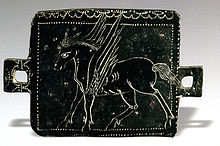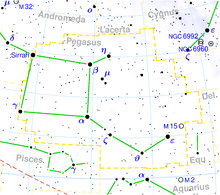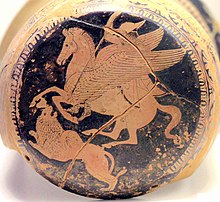Pegasus: Difference between revisions
Mboverload (talk | contribs) m Weekend typo raid, typos fixed: english → English using AWB |
|||
| Line 61: | Line 61: | ||
*The [[University of Strathclyde]] uses an online service called PEGASUS (Portal Engine Giving Access To [[Strathclyde]] University Systems)to provide its students with crucial information. |
*The [[University of Strathclyde]] uses an online service called PEGASUS (Portal Engine Giving Access To [[Strathclyde]] University Systems)to provide its students with crucial information. |
||
*In [[Sailor Moon SuperS]], Pegasus plays an important role, as he is the spirit of [[Helios]] and the keeper of the Golden Crystal. He lives inside the Golden Mirror, which is kept inside of beautiful dreamers. In the manga, he lives inside of [[Mamoru Chiba]]'s (Darien Shields) Golden Mirror of Beautiful Dreams. In the anime, Pegasus lives inside of [[Chibi-Usa]]'s (Rhini in the English dub) Golden Mirror of Beautiful Dreams. |
*In [[Sailor Moon SuperS]], Pegasus plays an important role, as he is the spirit of [[Helios]] and the keeper of the Golden Crystal. He lives inside the Golden Mirror, which is kept inside of beautiful dreamers. In the manga, he lives inside of [[Mamoru Chiba]]'s (Darien Shields) Golden Mirror of Beautiful Dreams. In the anime, Pegasus lives inside of [[Chibi-Usa]]'s (Rhini in the English dub) Golden Mirror of Beautiful Dreams. |
||
*In multiple games in the [[Fire Emblem]] series where pegasi are mounted by knights and called pegasus knights, or pegasus lords in their upgraded form. |
|||
==See also== |
==See also== |
||
Revision as of 19:20, 6 August 2008
This article needs additional citations for verification. (March 2008) |

In Greek mythology, Pegasus (Greek: Πήγασος, Pégasos, 'strong') was a winged horse that was the son of Poseidon, in his role as horse-god, and the Gorgon Medusa.
Etymology
Hesiod connects the name Pegasos with the word for "spring, well", pēgē; everywhere the winged horse struck his hoof to the earth, an inspiring spring burst forth: one on the Muses' Mount Helicon, the Hippocrene ("horse spring"), at the behest of Poseidon to prevent the mountain swelling too much and another at Troezen. The actual etymology of the name is most likely from Luwian pihassas "lightning", or pihassasas, a weather god (the god of lightning). In Hesiod, Pegasos is still associated with this original significance by carrying the thunderbolts for Zeus. Pegasus was at a well drinking silently when the hero Bellerophon came and captured him with a golden bridle that was given to him by Athena.Pegasus are also a sign of immortality
Birth
There are two versions of the winged stallion's birth and his brother Chrysaor:
- One is that they sprang from Medusa's neck as Perseus beheaded her, a "higher" birth, like the birth of Athena from the head of Zeus.
- Another says that they were born of the Earth as Medusa's blood spilled onto it, in which case Poseidon would not be their sire. A variation on this story holds that they were formed from the mingling of Medusa's blood and the sea foam, thus including Poseidon in their making.
Bellerophon caught and tamed Pegasus, and presented him to the Muses at Mount Parnassus. After he became the horse of the Muses, he was at the service of the poets.
Adventures

Pegasus aided the hero Bellerophon (or in later versions Perseus) in his fight against both the Chimera and the Amazons. There are varying tales as to how Bellerophon found Pegasus; the most common says that the hero was told by Polyeidos to sleep in the temple of Athena, where the goddess visited him in the night and presented him with a golden bridle. The next morning, still clutching the bridle, he found Pegasus drinking at the Pierian spring. When the steed saw the bridle, he approached Bellerophon and allowed him to ride. Bellerophon slew the Chimaera on Pegasus' back, and then tried to ride the winged horse to the top of Mount Olympus to see the gods. However, Zeus sent down a gadfly to sting Pegasus, causing Bellerophon to fall all the way back to Earth[1] the Plain of Aleion ("Wandering"), where he lived out his life in misery as a blinded cripple as punishment for trying to act as a god. Also, he was kept as Zeus' servant and stayed with him, never seeing Pegasus again.
Afterward, Pegasus found sanctuary on the sacred mountain, where he carried Zeus' thunderbolts and was ridden by Eos, the goddess of dawn.

In his later life, Pegasus took a mate, Euippe (or Ocyrrhoe), and had two children Celeris and Melanippe. This family is the origin of the winged horses. Celeris is associated with the constellation Equuleus.
Death
Pegasus was immortal. Because of his faithful service Zeus honored him with a constellation.[2] On the last day of his life, when Zeus transformed him into a constellation, a single feather fell to the earth near the city of Tarsus.[citation needed]
Modern Day Instances
In modern terminology, the word "pegasus" (plural "pegasi") has come to refer to any winged horse, though the term "pterippus" (meaning winged horse, plural "pterippi") is also used.
Psychology
In psychoanalysis, Freud interpreted the creature as an expression of the primal scene.[citation needed]
World War II

During WWII, the silhouetted image of Bellerophon the warrior, mounted on the winged Pegasus, was adopted by the United Kingdom's newly-raised parachute troops in 1941 as their upper sleeve insignia. The image clearly symbolized a warrior arriving at a battle by air, the same tactics used by paratroopers. The square upper-sleeve insignia comprised Bellerophon/Pegasus in light blue on a maroon background. The insignia was designed by famous English novelist Daphne du Maurier, who was married to the commander of the British parachute forces (and later the expanded British Airborne Forces), General Frederick "Boy" Browning. The maroon background on the insignia was later used again by the Airborne Forces when they adopted the famous maroon beret in Summer 1942. The beret was the origin of the German nickname for British airborne troops, The Red Devils. Today's Parachute Regiment carries on the maroon beret tradition.
During the airborne phase of the Normandy invasion on the night of 5-6 June 1944, British 6th Airborne Division captured all its key objectives in advance of the seaborne assault, including the capture and holding at all costs of a vital bridge over the Caen Canal, near Ouistreham. In memory of their tenacity, the bridge has been known ever since as Pegasus Bridge.
Corporate and Commercial Uses
Pegasus has been the symbol of the Mobil brand of gas and oil, marketed by the Exxon Mobil Corporation, since the 1930s. [3]. As such, it has also been a symbol of Dallas, Texas, gracing its skyline atop the Magnolia building.
The Poetry Foundation also uses Pegasus as its logo; the Buell Motorcycle Company uses Pegasus as a visual branding element.
Popular Culture
This section needs expansion. You can help by adding to it. (June 2008) |
- Pegasus is a character in the 1997 Disney animated film Hercules, in which he is the winged horse side kick and friend to Hercules the main character.
- In Clash of the Titans, Pegasus is captured by Perseus before Perseus visits and kills Medusa the Gorgon. This version, therefore changes the method of Pegasus' birth - although no further details are given, save a comment from Zeus that Pegasus is the sole surviving winged horse from a herd of the creatures, the rest killed by Thetis' son, Calibos.
- Pegasus is known for being the mascot of TriStar Pictures.
- The Taiwanese company Asus took its name from Pegasus, omitting the first three letters in order for the company to appear first in telephone listings.
- On an episode of Robot Chicken, Pegasus is caught in a bear trap planted by a demented little girl. He asks the girl to help him, but she cuts off his wings, keeps him in a barn, paints him like a My Little Pony toy, and names him "Sunny Muffins," whipping him in the barn until he accepts his name (similar to Kunta Kinte's whipping in Roots).Then she sits him down next to a painted griffin.
- Dark Pegasus is the name of a Murrieta, California based heavy metal group.
- In both versions of Battlestar Galactica, Pegasus is a Battlestar that survived the fall of the Twelve Colonies of Kobol, later meets up with Galactica, and is destroyed in a battle against the Cylons.
- Pegasus was chosen for the academic seal of the University of Central Florida, in 1963, by its first president, Dr. Charles Millican, who co-designed it.
- In Stargate Atlantis, Pegasus is the galaxy a race called the Ancients lived in millions of years ago.
- Pegasus is the name of a medevac helicopter based at the University of Virginia Medical Center. Pegasus transports critically injured patients within a 120 nautical miles of Charlottesville, VA. The name was chosen because it was different from most other medevac programs, and there are stories of Pegasus carrying wounded soldiers from battle. [4]
- In the movie, Barbie and the Magic of Pegasus, Pegasus is the winged horse who helps Princess Annika
- In the Companions Quartet, including Secret of the Sirens, Gorgons Gaze, Mines of the Minotaur and Chimeras Curse, Col Clamworthy was Companion to the Pegasi.
- In the video game God of War II, the protagonist Kratos is bidden by Gaia, the mother of the Titans and the franchise's narrator to find the Sisters of Fate in order to change his past. She gives Kratos the aid of Pegasus to traverse the distance to the Fates. Kratos and Pegasus, after a detour to a mountain that houses the Titan Typhon and former Titan Prometheus (who had been rendered mortal by Zeus), fly to the Island of Creation where the Sisters of Fate await.
- In Digimon 02, Patamon can digivolve into Pegasusmon using the Digi-Egg of Hope.
- The University of Strathclyde uses an online service called PEGASUS (Portal Engine Giving Access To Strathclyde University Systems)to provide its students with crucial information.
- In Sailor Moon SuperS, Pegasus plays an important role, as he is the spirit of Helios and the keeper of the Golden Crystal. He lives inside the Golden Mirror, which is kept inside of beautiful dreamers. In the manga, he lives inside of Mamoru Chiba's (Darien Shields) Golden Mirror of Beautiful Dreams. In the anime, Pegasus lives inside of Chibi-Usa's (Rhini in the English dub) Golden Mirror of Beautiful Dreams.
- In multiple games in the Fire Emblem series where pegasi are mounted by knights and called pegasus knights, or pegasus lords in their upgraded form.
See also
References
- ^ Parallels are in the myths of Icarus and Phaeton.
- ^ Scott Littleton:"Mythology. The Illustrated Anthology of World Myth & Storytelling", p 147. Duncan Baird Publishers, London, 2002. ISBN 1-903296-37-4
- ^ Pegasus - The Flying Horse
- ^ http://www.healthsystem.virginia.edu/internet/pegasus/pegasus.cfm
